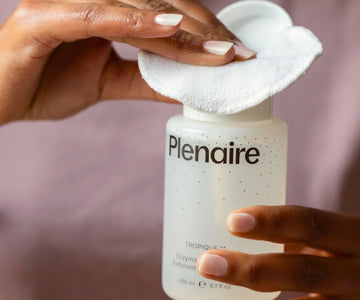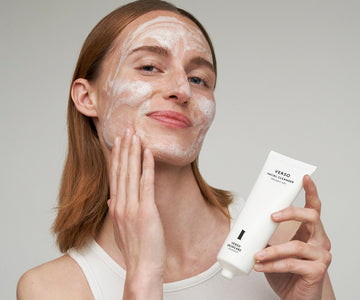
How to use a cleanser
To use a cleanser, first wet your face with warm water. Then, pump a small amount of cleanser into your hands and massage it into your skin in a circular motion. Rinse your face with warm water and pat it dry with a towel. The best way to use a cleanser is to apply it to damp skin, massage it in a circular motion for one-two minutes, leave it on to soak up dirt for a few minutes, and then wash it off. This method helps remove dirt, while also gently stimulating the skin without scratching.
How to apply toner to your skin
To apply toner, start by cleansing your face with a gentle cleanser. Next, soak a cotton ball or pad in toner and apply, avoiding the eye area. For best results, sweep the cotton pad across your face and neck in an upward direction. Then, wait for up to a minute for the toner to absorb into your skin. Finally, apply either a moisturiser or the next steps of your skincare routine to help either treat any specific skincare concerns or lock in the moisture. It's important to apply toner to your skin after cleansing, as it helps to remove any remaining dirt, oil, and makeup that your cleanser may have missed. Toner also prepares your skin for serums and moisturisers, particularly if the pH of the formulation is low, as our skin is naturally slightly acidic.
How to apply moisturiser to your face and neck
Start by applying a pea sized amount of the product to your skin, which you may directly apply in a few dots all over your face and neck. Apply gently in an upward, and outward direction across your face and neck. Use your fingers to gently massage the moisturiser into the skin in a circular motion. Be sure to avoid pulling or stretching your skin, making sure to always be super gentle. When applying eye cream, use the tips of two of your fingers to lightly pat the product underneath your eyes and across the brow bones. Dabbing and patting motions are much better than sweeping or rubbing, and they reduce puffiness at the same time.
How to use essences and serums
To get the most out of your skincare routine, it is important to understand how to use essences and serums. Both products are designed to help improve the appearance of your skin, but they work in different ways. Essences are typically made with water-based ingredients and are designed to be used after cleansing and before moisturising. They help to hydrate, replenish, and prep the skin for the next steps in your routine. Serums, on the other hand, usually feature active ingredients that are meant to penetrate the skin and target specific concerns. They should be used after cleansing, toning and essences, but before moisturising.
To get the most out of these products, be sure to follow the directions on the packaging as a start. Essences and serums should be applied by taking a few drops into your palm and then pressing the product into your skin, tapping where possible instead of using sweeping motions to avoid pulling on your delicate skin. When using an oil serum, you can use it as an opportunity to give yourself an extra facial massage, making sure to apply gentle pressure in an upwards and outwards motion.
How to make sure you're applying sunscreen correctly
Sunscreen is one of the most important steps of any skincare routine yet it's also one of the most misused skincare products. To make sure you're using sunscreen properly, start by making sure that you’re applying sunscreen to all exposed skin, including the neck, ears, and scalp – even on cloudy and office days. Reapply sunscreen every two hours, or more often if you're swimming or sweating, and when choosing a sunscreen, opt for one which features an SPF of at least 30 with broad-spectrum protection.
The Cautionary Don’ts:
Don’t ignore the instructions for use
Back during the dark ages of skincare (we’re talking walnut scrubs and alcohol-toners) products were limited to basic categories, and you could safely make assumptions about their functionality. Innovation has since meant that products are no longer confined to these categories and that stronger and more interesting formulations are continually being developed. This means that it’s important to read and follow the manufacturer’s instructions to get the best results from your skincare.
Avoid using too many products at once
When you’re trying to address a specific skincare concern, it can be tempting to use every tool in your skincare armoury to try and make the problem go away – sometimes all at once! However, when using products with active ingredients, it can be very easy to over-do it and either trigger a reaction or risk over-exfoliation. Keep your skincare routine simple and don’t make too many changes all at once, so you can really keep track of how every product affects your skin.
Give your products enough time to do their jobs
Very few skincare products claim to provide immediate results – and unless they’re masks or spot treatments, you should approach with caution if they do. As a rule of thumb, you need at least 28 days to see results, although you may need up to 3-6 months if we’re talking retinoids and actives that need to be introduced slowly. Changing up your routine too frequently can negatively impact your skin and cause confusion about what’s working and what really isn’t.






















